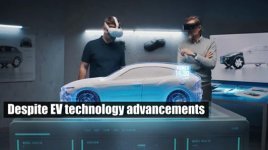evlover
Member
Legacy automakers are facing significant challenges as they navigate the transition to electric vehicles (EVs), and some are reconsidering their aggressive push toward fully electric lineups. Several key factors are contributing to this shift, including unsold inventories of EVs, consumer concerns, and the financial strain of producing electric cars. Here's a breakdown of the core issues driving this reconsideration:
1. Unsold Electric Vehicles & Slowed Growth
Despite a growing interest in EVs over the last few years, many automakers are now sitting on unsold EV inventories. The initial surge of enthusiasm appears to have plateaued, as consumers show hesitation over high costs, charging infrastructure limitations, and questions about long-term value, such as depreciation rates. Sales of hybrid vehicles, which offer a bridge between traditional combustion engines and fully electric power, are rebounding in response to this uncertainty.
2. The Consumer’s Power in EV Adoption
Consumers hold immense power in the adoption of EVs, and their concerns about charging times, range anxiety, and battery durability have slowed demand. While early adopters embraced the shift to electric, many mainstream buyers remain cautious, preferring the familiarity and convenience of gasoline-powered or hybrid vehicles. Automakers are realizing that a full transition to EVs may be premature without addressing these consumer concerns.
3. Government Policies: A Double-Edged Sword
Government incentives have been instrumental in driving EV adoption through subsidies, tax breaks, and regulations that favor low-emission vehicles. However, strict policies and regulations also put pressure on automakers to comply with emission targets, sometimes at the cost of profitability. The need to balance government mandates with market realities has left some automakers grappling with how to proceed, as they need to remain competitive while avoiding regulatory penalties.
4. Financial Strain of EV Production
Producing EVs remains costly. The development of new platforms, battery technology, and the infrastructure required to support EVs represent massive investments for automakers. Many legacy automakers are still reliant on the profits from their internal combustion engine (ICE) vehicles to fund their EV programs. As demand slows, the financial risk of over-investing in EVs without clear consumer demand has forced some companies to reconsider their pace of electrification.
5. Dealer Dilemmas
Dealerships play a crucial role in selling vehicles, but many are struggling to adapt to the changing landscape. EVs require less maintenance than traditional vehicles, which affects dealer revenue streams. Additionally, training sales staff on new technology and convincing traditional car buyers to switch to EVs has proven challenging for many dealerships.
6. Rising Customer Expectations
As EV technology evolves, customers expect more from these vehicles—longer ranges, faster charging, and lower prices. Automakers are struggling to meet these rising expectations while maintaining profitability. Consumers have become more demanding in terms of what they expect from their EV purchases, and if these expectations aren’t met, many are opting to stick with hybrid or gas-powered options.
7. Technological & Infrastructure Hurdles
Charging infrastructure remains a significant hurdle to widespread EV adoption. In many regions, the lack of a reliable and widespread network of fast chargers limits the practicality of owning an EV. Additionally, advances in battery technology, such as increasing energy density and reducing charging times, are still needed to make EVs more attractive to the broader market.
In light of these challenges, many legacy automakers are slowing down their EV rollouts and maintaining a diversified approach with hybrid and traditional gasoline vehicles. The fight for survival in a rapidly changing industry has led automakers to hedge their bets as they navigate technological, economic, and consumer-based challenges.

Youtube
1. Unsold Electric Vehicles & Slowed Growth
Despite a growing interest in EVs over the last few years, many automakers are now sitting on unsold EV inventories. The initial surge of enthusiasm appears to have plateaued, as consumers show hesitation over high costs, charging infrastructure limitations, and questions about long-term value, such as depreciation rates. Sales of hybrid vehicles, which offer a bridge between traditional combustion engines and fully electric power, are rebounding in response to this uncertainty.
2. The Consumer’s Power in EV Adoption
Consumers hold immense power in the adoption of EVs, and their concerns about charging times, range anxiety, and battery durability have slowed demand. While early adopters embraced the shift to electric, many mainstream buyers remain cautious, preferring the familiarity and convenience of gasoline-powered or hybrid vehicles. Automakers are realizing that a full transition to EVs may be premature without addressing these consumer concerns.
3. Government Policies: A Double-Edged Sword
Government incentives have been instrumental in driving EV adoption through subsidies, tax breaks, and regulations that favor low-emission vehicles. However, strict policies and regulations also put pressure on automakers to comply with emission targets, sometimes at the cost of profitability. The need to balance government mandates with market realities has left some automakers grappling with how to proceed, as they need to remain competitive while avoiding regulatory penalties.
4. Financial Strain of EV Production
Producing EVs remains costly. The development of new platforms, battery technology, and the infrastructure required to support EVs represent massive investments for automakers. Many legacy automakers are still reliant on the profits from their internal combustion engine (ICE) vehicles to fund their EV programs. As demand slows, the financial risk of over-investing in EVs without clear consumer demand has forced some companies to reconsider their pace of electrification.
5. Dealer Dilemmas
Dealerships play a crucial role in selling vehicles, but many are struggling to adapt to the changing landscape. EVs require less maintenance than traditional vehicles, which affects dealer revenue streams. Additionally, training sales staff on new technology and convincing traditional car buyers to switch to EVs has proven challenging for many dealerships.
6. Rising Customer Expectations
As EV technology evolves, customers expect more from these vehicles—longer ranges, faster charging, and lower prices. Automakers are struggling to meet these rising expectations while maintaining profitability. Consumers have become more demanding in terms of what they expect from their EV purchases, and if these expectations aren’t met, many are opting to stick with hybrid or gas-powered options.
7. Technological & Infrastructure Hurdles
Charging infrastructure remains a significant hurdle to widespread EV adoption. In many regions, the lack of a reliable and widespread network of fast chargers limits the practicality of owning an EV. Additionally, advances in battery technology, such as increasing energy density and reducing charging times, are still needed to make EVs more attractive to the broader market.
In light of these challenges, many legacy automakers are slowing down their EV rollouts and maintaining a diversified approach with hybrid and traditional gasoline vehicles. The fight for survival in a rapidly changing industry has led automakers to hedge their bets as they navigate technological, economic, and consumer-based challenges.

Youtube
